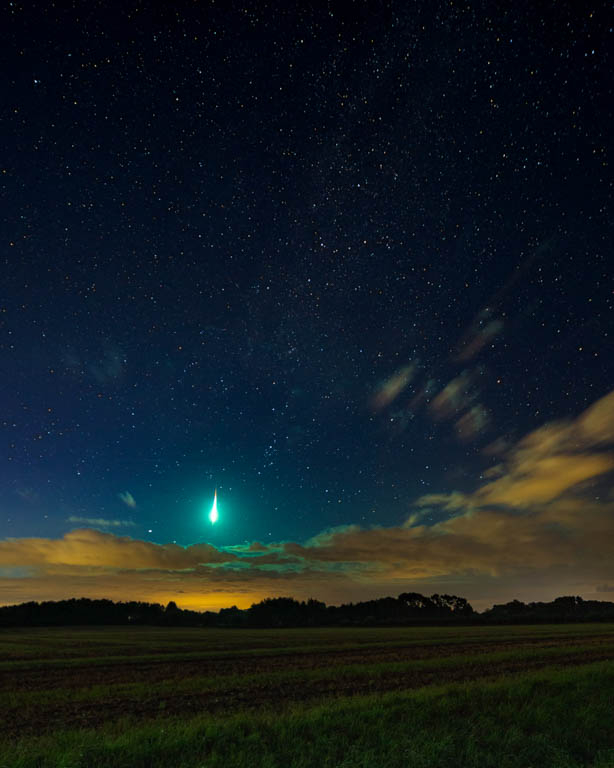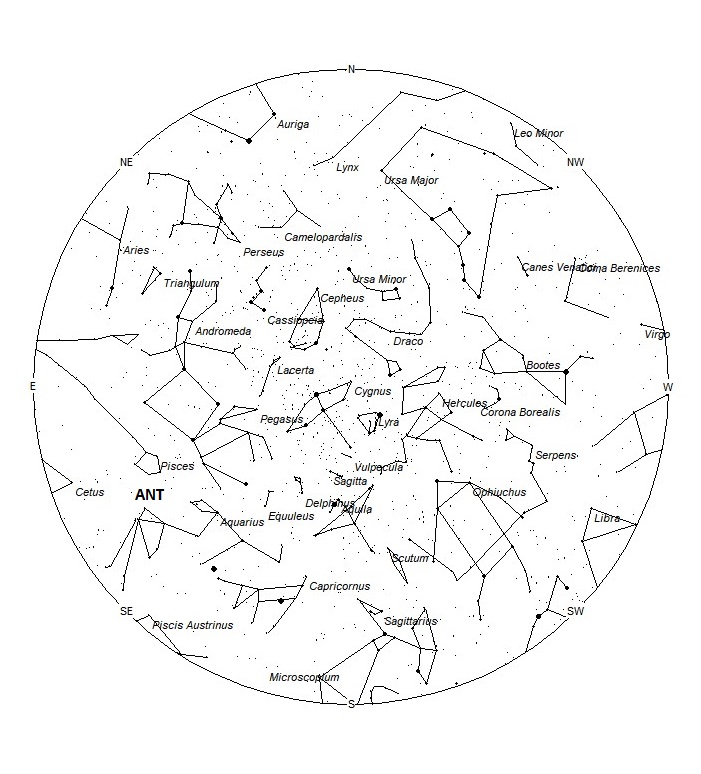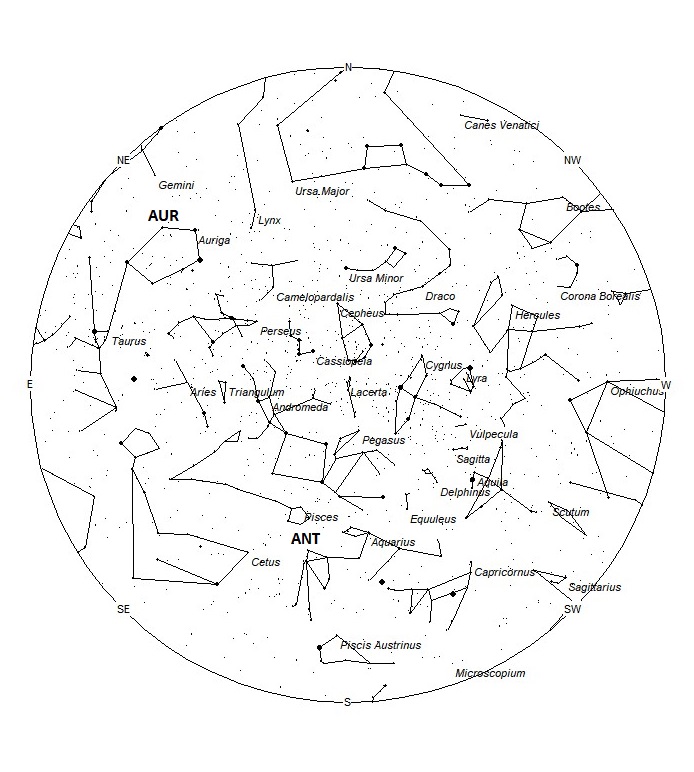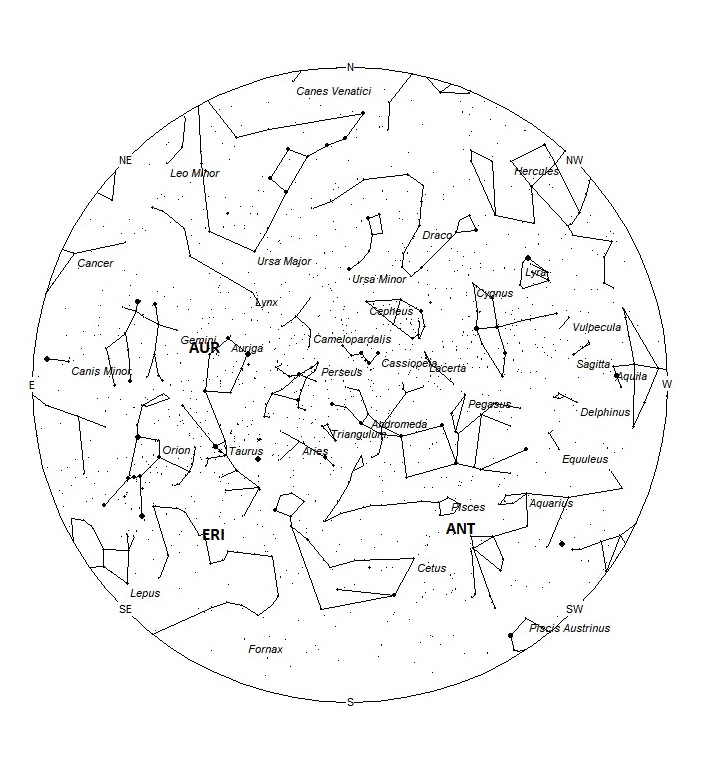 Olaf Toepper captured this bright fireball at 23:20 CEST (21:20 UT) on 7 August 2021 from Hohenhorn, Germany. For more information on this event visit: https://fireball.amsmeteors.org/members/imo_view/event/2021/4397 ©Olaf Toepper
Olaf Toepper captured this bright fireball at 23:20 CEST (21:20 UT) on 7 August 2021 from Hohenhorn, Germany. For more information on this event visit: https://fireball.amsmeteors.org/members/imo_view/event/2021/4397 ©Olaf ToepperSeptember offers longer nights in the northern hemisphere that tend to be less hazy than those experienced in mid-summer. In the sky, no major showers are visible from either hemisphere, but the northern hemisphere enjoys the advantage of higher sporadic rates. Most of the shower activity this month is produced from the Perseus-Aurigid complex active this time of year. These showers rarely produce more than 5 meteors per hour but still manage to produce most of the shower activity seen this month. Unfortunately, the Perseus-Aurigid complex lies too low in the northern sky for southern hemisphere observers to view very well. Video studies have shown that the Taurids are visible as early as September 28th, therefore after this date the Anthelion radiant will no longer be listed until the Taurid showers end in December. The Anthelion meteors are still active but their radiant is superimposed upon that of the more numerous Taurids, therefore it is impossible to properly separate these meteors. Observers in the southern hemisphere suffer from some of their lowest rates of the year this month. The Taurid radiants are not too badly placed so observers south of the equator can expect to see a little of this activity from this source this month.
During this period, the moon reaches its last quarter phase on Monday August 30th. At that time the moon lies 90 degrees west of the sun and rises near 23:00 local summer time (LST) on Sunday August 29th. During this period evening skies will be free of interfering moonlight, but morning observers must take care to avoid the moon within their field of view. The moon rises later with each passing night enlarging the window of opportunity to view meteor activity under darker skies. The estimated total hourly meteor rates for evening observers this week is near 4 as seen from mid-northern latitudes (45N) and 3 as seen from tropical southern locations (25S). For morning observers, the estimated total hourly rates should be near 12 as seen from mid-northern latitudes (45N) and 8 as seen from tropical southern locations (25S). The actual rates will also depend on factors such as personal light and motion perception, local weather conditions, alertness, and experience in watching meteor activity. Morning rates are reduced this week due to interfering moonlight. Note that the hourly rates listed below are estimates as viewed from dark sky sites away from urban light sources. Observers viewing from urban areas will see less activity as only the brighter meteors will be visible from such locations.
The radiant (the area of the sky where meteors appear to shoot from) positions and rates listed below are exact for Saturday night/Sunday morning August 28/29. These positions do not change greatly day to day so the listed coordinates may be used during this entire period. Most star atlases (available at science stores and planetariums) will provide maps with grid lines of the celestial coordinates so that you may find out exactly where these positions are located in the sky. I have also included charts of the sky that display the radiant positions for evening, midnight, and morning. The center of each chart is the sky directly overhead at the appropriate hour. These charts are oriented for facing south but can be used for any direction by rotating the charts to the desired direction. A planisphere or computer planetarium program is also useful in showing the sky at any time of night on any date of the year. Activity from each radiant is best seen when it is positioned highest in the sky, either due north or south along the meridian, depending on your latitude. It must be remembered that meteor activity is rarely seen at the radiant position. Rather they shoot outwards from the radiant, so it is best to center your field of view so that the radiant lies at the edge and not the center. Viewing there will allow you to easily trace the path of each meteor back to the radiant (if it is a shower member) or in another direction if it is sporadic. Meteor activity is not seen from radiants that are located far below the horizon. The positions below are listed in a west to east manner in order of right ascension (celestial longitude). The positions listed first are located further west therefore are accessible earlier in the night while those listed further down the list rise later in the night.
These sources of meteoric activity are expected to be active this week.
.
The center of the large Anthelion (ANT) radiant is currently located at 23:12 (348) -03. This position lies in northeastern Aquarius, 3 degrees north of the 4th magnitude star known as phi Aquarii. Due to the large size of this radiant, Anthelion activity may also appear from western Pisces as well as Aquarius. This radiant is best placed near 0100 LST, when it lies on the meridian and is located highest in the sky. Rates at this time should be near 2 per hour no matter your location. With an entry velocity of 30 km/sec., the average Anthelion meteor would be of slow velocity.
The eta Eridanids (ERI) are active from a radiant near 04:00 (060) -07. This position lies in northern Eridanus, 3 degrees west of the magnitude star known as Beid (omicron1 Eridani). This source is active until September 10th, with maximum activity occurring on August 6th. Current rates would be less than 1 per hour no matter your location. These meteors are best seen during the last dark hour prior to dawn when the radiant lies highest above the horizon in a dark sky. With an entry velocity of 64 km/sec., the average meteor from this source would be of swift speed.
The Aurigids (AUR) are active from August 28 through September 5, peaking on August 31st (Universal Time). At maximum the radiant is located at 06:04 (091) +39. This position lies in eastern Auriga, 2 degrees northeast of the 3rd magnitude star known as Mahasim (theta Aurigae A). This area of the sky is best seen during the last dark hour before dawn when the radiant lies highest in a dark sky. Normally, hourly rates are less than 1 except on the night of maximum activity. This year there is the possibility of an outburst occurring between 21:15 and 21:45 UT. This timing favors Asia and northeastern Europe. Zenith hourly rates of 50-100 are predicted within this time frame. Unfortunately, a waning crescent moon will be located in the same region of the sky as Auriga, therefore observed rates are bound to be considerably less. With an entry velocity of 66 km/sec., the average meteor from this source would be of swift velocity.
As seen from the mid-northern hemisphere (45N) one would expect to see approximately 10 sporadic meteors per hour during the last hour before dawn as seen from rural observing sites. Evening rates would be near 3 per hour. As seen from the tropical southern latitudes (25S), morning rates would be near 6 per hour as seen from rural observing sites and 2 per hour during the evening hours. Locations between these two extremes would see activity between the listed figures. Morning rates are reduced due to moonlight.
|
SHOWER |
DATE OF MAXIMUM ACTIVITY | CELESTIAL POSITION | ENTRY VELOCITY | CULMINATION | HOURLY RATE | CLASS |
| RA (RA in Deg.) DEC | Km/Sec | Local Daylight Saving Time | North-South | |||
| Anthelion (ANT) | – | 23:12 (348) -03 | 30 | 02:00 | 2 – 2 | II |
| eta Eridanids (ERI) | Aug 06 | 04:00 (060) -07 | 64 | 07:00 | <1 – <1 | II |
| Aurigids (AUR) | Aug 31 | 06:04 (091) +39 | 66 | 09:00 | ? | III |







 You saw something bright and fast? Like a huge shooting star? Report it: it may be a fireball.
You saw something bright and fast? Like a huge shooting star? Report it: it may be a fireball.  You counted meteors last night? Share your results with us!
You counted meteors last night? Share your results with us!  You took a photo of a meteor or fireball? You have a screenshot of your cam? Share it with us!
You took a photo of a meteor or fireball? You have a screenshot of your cam? Share it with us!  You caught a meteor or fireball on video? Share your video with us!
You caught a meteor or fireball on video? Share your video with us!
One comment
Awesome photos